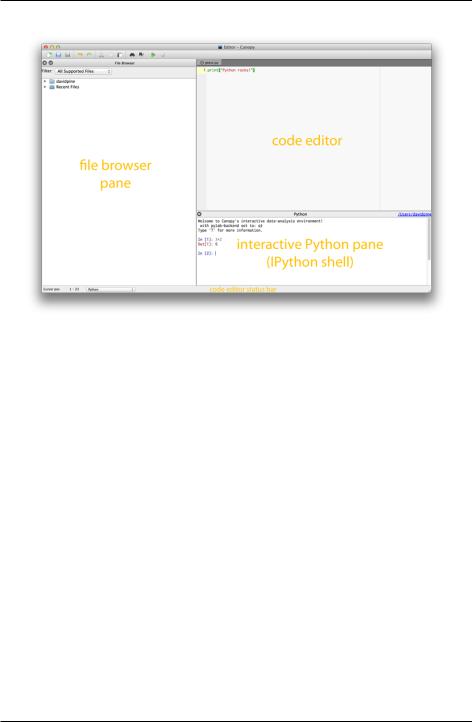
- •Introduction
- •Introduction to Python and its use in science
- •Launching Python
- •Installing Python on your computer
- •The Canopy window
- •The Interactive Python Pane
- •Interactive Python as a calculator
- •Python Modules
- •Variables
- •Importing Modules
- •Getting help: documentation in IPython
- •Programming is a detail-oriented activity
- •Exercises
- •Strings, Lists, Arrays, and Dictionaries
- •Strings
- •Lists
- •NumPy arrays
- •Dictionaries
- •Random numbers
- •Exercises
- •Input and Output
- •Keyboard input
- •Screen output
- •File input
- •File output
- •Exercises
- •Plotting
- •An interactive session with pyplot
- •Basic plotting
- •Logarithmic plots
- •More advanced graphical output
- •Exercises
- •Conditionals and Loops
- •Conditionals
- •Loops
- •List Comprehensions
- •Exercises
- •Functions
- •Methods and attributes
- •Exercises
- •Curve Fitting
- •Exercises
- •Numerical Routines: SciPy and NumPy
- •Special functions
- •Linear algebra
- •Solving non-linear equations
- •Solving ODEs
- •Discrete (fast) Fourier transforms
- •Exercises
- •Installing Python
- •IPython Notebooks
- •Python Resources

CHAPTER
TWO
LAUNCHING PYTHON
2.1 Installing Python on your computer
If you haven’t already installed Python on your computer, see Installing Python, which includes instructions for installing Python on Macs running under MacOSX and on PCs running under Windows.
Once you have installed Python, find the Canopy icon on your computer and launch the application. Wait for the Canopy welcome screen to appear, and then click on the Editor icon. The Canopy window should appear, like the one shown below. This is the window you will generally use to work with Python.
2.2 The Canopy window
The default Canopy window has three panes: the code editor, the interactive Python pane, and the file browser pane. The interactive Python pane is the primary way that you interact with Python. You can use it to run Python computer programs, test snippets of Python code, navigate your computer file directories, and perform system tasks like creating, moving, and deleting files and directories. You will use the code editor to write and edit Python programs (or scripts), which are simply sequences of Python commands (code) stored in a file on your computer. The file browser pane allows you to navigate your computer’s file directory system in order to view and retrieve files on your computer.
The individual panes in the Canopy window are reconfigurable and detachable but we will leave them pretty much as they are for now. However, you may want to adjust the overall size of the window to suit your computer screen. You can find more information
5

Introduction to Python for Science, Release 0.9.23
Figure 2.1: Canopy window
about Canopy in the Documentation Browser, which you can access through the Welcome to Canopy window.
2.3 The Interactive Python Pane
The default input prompt of the interactive Python pane looks like this:
In [1]:
This means that Canopy is running a particular version or “shell” of interactive Python called IPython. The IPython shell has been specifically designed for scientific and engineering use. The standard Python interactive shell uses the prompt >>>. You can pretty much do everything you want to do with either shell, but we will be using the IPython shell as we want to take advantage of some of its special features for scientific computing.
By typing short commands at the prompt, IPython can be used to perform various system tasks, such as running programs and creating and moving files around on your computer. This is a different kind of computer interface than the icon-based interface (or “graphical user interface” GUI) that you usually use to communicate with your computer. While
6 |
Chapter 2. Launching Python |

Introduction to Python for Science, Release 0.9.23
it may seem more cumbersome for some tasks, it can be more powerful for other tasks, particularly those associated with programming.
Before getting started, we point out that like most modern computer languages, Python is case sensitive. That is, Python distinguishes between upper and lower case letters. Thus, two words spelled the same but having different letters capitalized are treated as different names in Python. Keep that in mind as we introduce different commands.
2.3.1 Magic Functions
IPython features a number of commands called “magic” commands that let you perform various useful tasks. There are two types of magic commands, line magic commands that begin with %—these are executed on a single line—and cell magic commands that begin with %%—these are executed on several lines. Here we will concern ourselves only with line magic commands.
The first thing to know about magic commands is that you can toggle (turn on and off) the need to use the % prefix for line magic commands by typing %automagic. By default, the Automagic switch is set to ON so you don’t need the % prefix. To set Automagic to OFF, simply type %automagic at the IPython prompt. Cell magic commands always need the %% prefix.
In what follows below, we assume that the Automagic switch is set to ON so we omit the % sign.
Navigation Commands
IPython recognizes several common navigation commands that are used under the Unix/Linux operating systems. In the IPython shell, these few commands work on Macs, PCs, and Linux machines.
At the IPython prompt, type cd ~ (i.e. “cd” – “space” – “tilde” , where tilde is found near the upper left part of most keyboards). This will set your computer to its home (default) directory. Next type pwd (print working directory) and press RETURN. The console should return the path of the current directory of your computer. It might look like this on a Mac:
In [2]: pwd
Out[2]: u’/Users/pine’
or this on a PC:
2.3. The Interactive Python Pane |
7 |

Introduction to Python for Science, Release 0.9.23
In [3]: pwd
Out[3]: C:\\Users\\pine
Typing cd .. (“cd” – “space” – two periods) moves the IPython shell up one directory in the directory tree, as illustrated by the set of commands below.
In [4]: cd .. /Users
In [5]: pwd
Out[5]: u’/Users’
The directory moved up one from /Users/pine to /Users. Now type ls (list) and press RETURN. The console should list the names of the files and subdirectories in the current directory.
In [6]: ls
Shared/ pine/
In this case, there are only two directories (indicated by the slash) and not files. Type cd ~ again to return to your home directory and then type pwd to verify where you are in your directory tree. [Technically, ls isn’t a magic command, but typing it without the % sign lists the contents of the current directory, irrespective of whether Automagic is ON or OFF.]
Let’s create a directory within your documents directory that you can use to store your Python programs. We will call it PyProgs. First, return to your home directory by typing cd ~. To create directory PyProgs, type mkdir PyProgs (make directory). Type ls to confirm that you have created PyProgs and then type cd PyProgs to switch to that directory.
Now let’s say you want to return to the previous subdirectory, Documents or My Documents, which should be one up in the directory tree if you have followed along. Type cd .. and then type pwd. You should find that you are back in the previous directory, Documents or My Documents. If you type ls, you should see the new directory PyProgs that you just created.
More Magic Commands
The most important magic command is %run filename where filename is the name of a Python program you have created. We haven’t done this yet but include it here just for reference. We will come back to this later.
8 |
Chapter 2. Launching Python |

Introduction to Python for Science, Release 0.9.23
Some other useful magic commands include %hist, which lists the recent commands issued to the IPython terminal, and %edit, which opens a new empty file in the code editor window. Typing %edit filename, will open the file filename if it exists in the current directory, or it will create a new file by that name if it does not, and will open it as a blank file in the code editor window.
There are a number of other magic commands. You can get a list of them by typing lsmagic.
In [7]: lsmagic Available line magics:
%alias %alias_magic %autocall %automagic %bookmark %cd %clear %colors %config %connect_info %debug %dhist %dirs %doctest_mode %ed %edit %env %gui %guiref %hist %history %install_default_config %install_ext %install_profiles %killbgscripts %less %load %load_ext %loadpy %logoff %logon
%logstart %logstate %logstop |
%lsmagic %macro |
%magic |
%man |
|
%more %notebook %page %pastebin %pdb %pdef |
%pdoc |
%pfile |
||
%pinfo %pinfo2 %popd %pprint %precision %profile %prun |
||||
%psearch %psource %pushd %pwd %pycat %pylab %qtconsole |
||||
%quickref %recall %rehashx %reload_ext %rep |
%rerun |
%reset |
||
%reset_selective %run %save |
%sc %store |
%sx |
%system |
%tb |
%time %timeit %unalias %unload_ext %who |
%who_ls %whos |
|||
%xdel %xmode |
|
|
|
|
Available cell |
magics: |
|
|
%%! %%bash %%capture |
%%file %%javascript %%latex %%perl |
||
%%prun |
%%pypy |
%%python %%python3 %%ruby %%script %%sh %%svg |
|
%%sx |
%%system |
%%timeit |
|
Automagic is ON, % prefix IS NOT needed for line magics.
There are a lot of magic commands, most of which we don’t need right now. We will introduce them in the text as needed.
2.3.2 System shell commands
You can also run system shell commands from the IPython shell by typing ! followed by a system shell command. For Macs running OSX and for Linux machines, this means that Unix (or equivalently Linux) commands can be issued from the IPython prompt. For PCs, this means that Windows (DOS) commands can be issued from the IPython prompt. For example, typing !ls (list) and pressing RETURN lists all the files in the current directory on a Mac. Typing !dir on a PC does essentially the same thing (note that system shell commands in Windows are not case sensitive).
2.3. The Interactive Python Pane |
9 |

Introduction to Python for Science, Release 0.9.23
2.3.3 Tab completion
IPython also incorporates a number of shortcuts that make using the shell more efficient. One of the most useful is tab completion. Let’s assume you have been following along and that your are in the directory Documents or My Documents. To switch to the directory PyProgs, you could type cd PyProgs. Instead of doing that, type cd PyP and then press the TAB key. This will complete the command, provided there is no ambiguity in how to finish the command. In the present case, that would mean that there was no other subdirectory beginning with PyP. Tab completion works with any command you type into the IPython terminal. Try it out! It will make your life more wonderful.
A related shortcut involves the " key. If you type a command, say cd and then to press the " key, IPython will complete the cd command with the last instance of that command. Thus, when you launch IPython, you can use this shortcut to take you to the directory you used when you last ran IPython.
You can also simply press the " key, which will simply recall the most recent command. Repeated application of the " key scrolls though the most recent commands in reverse order. The # key can be used to scroll in the other direction.
2.3.4 Recap of commands
Let’s recap the (magic) commands introduced above:
pwd: (print working directory) Prints the path of the current directory.
ls: (list) Lists the names of the files and directories located in the current directory.
mkdir filename: (make directory) Makes a new directory filename.
cd directoryname: (change directory) Changes the current directory to directoryname. Note: for this to work, directoryname must be a subdirectory in the current directory. Typing cd ~ changes to the home directory of your computer. Typing cd .. moves the console one directory up in the directory tree.
clear: Clears the IPython screen of previous commands.
run filename: Runs (executes) a Python script. Described later in the section Scripting Example 1
Tab completion: Provides convenient shortcuts, with or without the arrow keys, for executing commands in the IPython shell.
10 |
Chapter 2. Launching Python |
